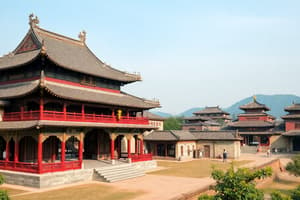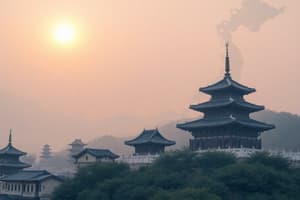Podcast
Questions and Answers
Who is credited with having authored or edited many of the Chinese classic texts, including all of the Five Classics?
Who is credited with having authored or edited many of the Chinese classic texts, including all of the Five Classics?
Confucius
What political philosophy is Sun-Yat-Sen known for developing?
What political philosophy is Sun-Yat-Sen known for developing?
Three Principles of the People: nationalism, democracy, and the people’s livelihood
Who led the Northern Expedition to unify China in the 20th century?
Who led the Northern Expedition to unify China in the 20th century?
Chiang Kai-Shek
What principle is associated with Confucius and resembles the Golden Rule?
What principle is associated with Confucius and resembles the Golden Rule?
In which period of Chinese history did Confucius live?
In which period of Chinese history did Confucius live?
Which animal species can be found in cold coniferous forests in the north of China?
Which animal species can be found in cold coniferous forests in the north of China?
Where is the People's Republic of China located?
Where is the People's Republic of China located?
What are the two regions into which China is generally divided?
What are the two regions into which China is generally divided?
Which region of China is sparsely populated?
Which region of China is sparsely populated?
What is the capital city of the People's Republic of China?
What is the capital city of the People's Republic of China?
What was the purpose of building 'The Great Wall of China'?
What was the purpose of building 'The Great Wall of China'?
What are the main religions in China?
What are the main religions in China?
Flashcards are hidden until you start studying
Study Notes
Geography and Climate
- China has cold coniferous forests in the north, supporting animal species like moose and the Asian black bear, and over 120 bird species.
- Moist conifer forests can have thickets of bamboo or rhododendrons as an understorey, depending on the elevation.
- Subtropical forests dominate central and southern China, supporting as many as 146,000 species of flora.
- Tropical and seasonal rainforests contain a quarter of all the plant and animal species found in China.
History
- China became a communist state in 1949.
- The "Cultural Revolution" was launched in the 1960s to replace the party-government-military-power elite with more revolutionary elements.
- China profited from developments in foreign relations, including its admission to the United Nations.
Politics and Government
- The People's Republic of China (PRC) and the Republic of China (ROC) assert identical claims over the Spratly Islands in the South China Sea.
- The southern-most extent of these claims reaches Zengmu Ansha (James Shoal), which would form a maritime frontier with Malaysia.
Famous People
- Confucius was a Chinese teacher, editor, politician, and philosopher who championed strong family loyalty, ancestor worship, and respect of elders.
- He recommended family as a basis for ideal government and espoused the principle "Do not do to others what you do not want done to yourself".
- Sun Yat-sen was a Chinese revolutionary and first president and founding father of the Republic of China, who developed the Three Principles of the People: nationalism, democracy, and the people's livelihood.
- Chiang Kai-shek was a political and military leader of 20th-century China, who led the Northern Expedition to unify the country and became China's nominal leader.
- Mao Zedong was a Chinese communist revolutionary and founder of the People's Republic of China, who popularized the principles of communism.
Country Overview
- The People's Republic of China is located in East Asia and is the third-largest country in the world with an area of 9,561,000 square kilometers.
- It is the most populous country with over 1.2 billion people and is generally divided into two regions: Western or Outer China and Eastern or Inner China.
- The Outer Region includes over half of the land area of the country but is sparsely populated, while the Inner Region is one of the most densely populated areas in the world.
- Beijing, the capital of the People's Republic of China, is located in the northeastern part of the country and has hot and humid summers and cold and dry winters.
Culture and Religions
- Mandarin is the official language of China.
- The main religions of China are Confucianism, Taoism, Buddhism, Christianity, and Islam.
- The Great Wall of China, built in the 3rd century, is one of the Seven Wonders of the World and extends over 2,400 km.
Studying That Suits You
Use AI to generate personalized quizzes and flashcards to suit your learning preferences.




